Who Wants To Be A Millionaire?
 The Game: You mean you’re the one person in the country who doesn’t know all the rules and the lifelines? Well, ooooooookay. The computer (sitting in for Regis Philbin) asks you a series of questions with four possible answers. Only one of these is the correct answer. If you’re not sure, you can ask an equally-computerized audience or phone a quasi-friend (actually, the phone-a-friend option in ABC.com’s online version of the game draws from a bank of answers given by people who have actually been contestants on the show), or you can eliminate two of the wrong answers. If you guess the wrong answer, you wind up going home a little less rich than you might be if you simply walk away. (ABC.com, 1999 – this game has since been removed from the site)
The Game: You mean you’re the one person in the country who doesn’t know all the rules and the lifelines? Well, ooooooookay. The computer (sitting in for Regis Philbin) asks you a series of questions with four possible answers. Only one of these is the correct answer. If you’re not sure, you can ask an equally-computerized audience or phone a quasi-friend (actually, the phone-a-friend option in ABC.com’s online version of the game draws from a bank of answers given by people who have actually been contestants on the show), or you can eliminate two of the wrong answers. If you guess the wrong answer, you wind up going home a little less rich than you might be if you simply walk away. (ABC.com, 1999 – this game has since been removed from the site)
Memories: Admittedly, I’m waiting for Sony to get it in gear and release the Playstation version of Millionaire in late June, but for now, there’s the rather good online version of the game on ABC’s web site. At the behest of the benign overlords as Disney, ABC.com repeatedly – and I do mean repeatedly – reminds you that you’re not playing for any kind of money or prizes.
Star Trek: Starfleet Command
![]()
 The Game: As the captain of one of Starfleet’s ships of the line, your assignments range from routine patrol duty to full-on combat with Klingons, Romulans, Hydrans, Lyrans or Gorn. You may eventually even attain control of a small fleet, issuing orders to each ship in turn to accomplish your mission. Standard 23rd century armaments like phasers and photon torpedoes are at your disposal, as are other offensive measures as sensor decoys and suicide shuttles. But remember, since Starfleet’s the good guys, the enemy will always have more wicked weapons than you. Stay on your toes, Captain. (Interplay, 1999)
The Game: As the captain of one of Starfleet’s ships of the line, your assignments range from routine patrol duty to full-on combat with Klingons, Romulans, Hydrans, Lyrans or Gorn. You may eventually even attain control of a small fleet, issuing orders to each ship in turn to accomplish your mission. Standard 23rd century armaments like phasers and photon torpedoes are at your disposal, as are other offensive measures as sensor decoys and suicide shuttles. But remember, since Starfleet’s the good guys, the enemy will always have more wicked weapons than you. Stay on your toes, Captain. (Interplay, 1999)
Memories: How close did this game come to being classified as a Retro Revival? It’s based on a pencil-paper-and-dice turn-based tactical game that’s older than even Pac-Man. We’re talking, of course, about Star Fleet Battles, which served as the inspiration for this really snazzy bit of Trek gaming. Who doesn’t remember the 20-sided dice, the hex-grid maps, and the starship markers and miniatures with the hexagonal bases? I’d go so far as to say that Star Fleet Battles kept the Trek franchise alive in the minds of fans the same way that Kenner’s action figures kept the faithful adhered to the Star Wars saga, even after the third movie passed with no signs of a seuqel or prequel to come.
The X-Files
![]()
 The Game: FBI agents Fox Mulder and Dana Scully are investigating a mysterious disappearance at a wharfside warehouse when they come under fire themselves – and then become the next to disappear. As junior FBI agent Craig Willmore, you are assigned to the case. Your mission is to find out what happened to Scully and Mulder…but in the course of investigating this case, you’ll find that you’re vastly underequipped to take on a job where enormous opposition will stop at nothing to prevent you from finding them. (Fox Interactive [developed by Hyperbole Studios, 1999)
The Game: FBI agents Fox Mulder and Dana Scully are investigating a mysterious disappearance at a wharfside warehouse when they come under fire themselves – and then become the next to disappear. As junior FBI agent Craig Willmore, you are assigned to the case. Your mission is to find out what happened to Scully and Mulder…but in the course of investigating this case, you’ll find that you’re vastly underequipped to take on a job where enormous opposition will stop at nothing to prevent you from finding them. (Fox Interactive [developed by Hyperbole Studios, 1999)
Memories: I’m torn on this game. On one hand, it’s an exceptionally cool concept – the “interactive movie” experience that has been sought by game makers since the days of the 1983 laserdisc cartoon game Dragon’s Lair. But on the other hand, it’s a frustratingly limited (and limiting) game, not unlike that same dragon-slaying opus of yesteryear.
Xena: Warrior Princess
![]()
 The Game: An evil sorceress, in her plot to destroy the gods, needs to sacrifice a mortal queen – and decides that Gabrielle will do, since the bard is also the Queen of the Amazons. Xena must fight her way through numerous obstacles to challenge the might of the sorceress and defeat her – the world, and Gabrielle’s life, depend on her success. (Electronic Arts, 1999)
The Game: An evil sorceress, in her plot to destroy the gods, needs to sacrifice a mortal queen – and decides that Gabrielle will do, since the bard is also the Queen of the Amazons. Xena must fight her way through numerous obstacles to challenge the might of the sorceress and defeat her – the world, and Gabrielle’s life, depend on her success. (Electronic Arts, 1999)
Memories: Xena is a natural property for a video game, and indeed, there have already been games on earlier platforms that explored the Xenaverse. But this multi-level, first-person fighting game is the first to attempt to match the scope of the television series, offering individual “episodes” to fight your way through en route to the final goal.
Star Wars Episode I: Racer
![]() The Game: Strap yourself into the very fast, very dangerous world of pod racing. Rocket through dozens of different courses, facing off against opponents who
The Game: Strap yourself into the very fast, very dangerous world of pod racing. Rocket through dozens of different courses, facing off against opponents who  range from patsies to cunning and ruthless adversaries. Save up your winnings along the way to make your pod faster and handle better. Aim for the Boonta Eve race on Tatooine and try to win it all. (LucasArts, 1999)
range from patsies to cunning and ruthless adversaries. Save up your winnings along the way to make your pod faster and handle better. Aim for the Boonta Eve race on Tatooine and try to win it all. (LucasArts, 1999)
Memories: The first video game released in conjunction with The Phantom Menace is this racing game developed by LucasArts. This game holds the distinction of having one of the oddest titles (and dullest packaging) in recent years, but inside is a decent and fun little racing game.
Star Wars Episode I: The Phantom Menace
 Memories: As various heroic characters from the days when Jedi Knights still enforced justice in that galaxy far, far away, you must expose the danger posed to peaceful Naboo by the Trade Federation’s army of battle and destroyer droids, and escort
Memories: As various heroic characters from the days when Jedi Knights still enforced justice in that galaxy far, far away, you must expose the danger posed to peaceful Naboo by the Trade Federation’s army of battle and destroyer droids, and escort  Queen Amidala out of the clutches of the invaders who would force her to surrender her world into slavery. (LucasArts, 1999)
Queen Amidala out of the clutches of the invaders who would force her to surrender her world into slavery. (LucasArts, 1999)
Memories: Oh, what a frustrating game! The Playstation is a recent acquisition for me, and I like the wealth of Retro Revivals and emulations available for Sony’s nifty little game console. But this game and the Xena game just about drove me nuts…yet this is the style of game that most everyone seems to be trying to create these days.
South Park: Chef’s Luv Shack
![]()
 The Game: Chef’s got his own cable access game show where eligible bachelorettes can compete for his affections! However, in the total absence of eligible bachelorettes, Kyle, Stan, Kenny and Cartman have shown up to play the game. They answer three rounds of Who Wants To Be A Millionaire-style trivia (only much more scatological than Regis usually gets) and then go into a randomly-selected “mini-game.” To the victor goes the Cheesy Poofs! (Acclaim Studios Austin, 1999)
The Game: Chef’s got his own cable access game show where eligible bachelorettes can compete for his affections! However, in the total absence of eligible bachelorettes, Kyle, Stan, Kenny and Cartman have shown up to play the game. They answer three rounds of Who Wants To Be A Millionaire-style trivia (only much more scatological than Regis usually gets) and then go into a randomly-selected “mini-game.” To the victor goes the Cheesy Poofs! (Acclaim Studios Austin, 1999)
Memories: This hysterically funny party game is a hit around the Green household. Now, just the presence of the words “South Park” will very likely tell you that this isn’t a game to get for your kids. With that in mind, it’s still a good game.
Space Invaders
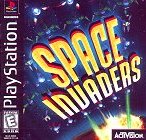
 The Game: 21 years after the first relentless alien invasion of Earth, the Space Invaders are back – and so are you, in a vastly advanced version of the ubiquitous “tank” which was so critical to the defense of Earth in 1978. But the aliens have made some improvements to their hardware too, and they still outnumber you by at least 20 to 1. Handy survival tip: start blasting, and keep blasting. (Activision, 1999)
The Game: 21 years after the first relentless alien invasion of Earth, the Space Invaders are back – and so are you, in a vastly advanced version of the ubiquitous “tank” which was so critical to the defense of Earth in 1978. But the aliens have made some improvements to their hardware too, and they still outnumber you by at least 20 to 1. Handy survival tip: start blasting, and keep blasting. (Activision, 1999)
Memories: Now this retro revival surprised me. Updating Pac-Man and Q*Bert, that I could see. Those games had Saturday morning cartoons, vague plotlines of their own (in fine print on the arcade cabinets), and so they’re easy to update. Space Invaders, on the other hand, had a T-shirt, and a legacy of many wasted after-school hours spent on the Atari 2600. The only plotline one could assign to Space Invaders was that you could fight and fight and fight, but you’d eventually perish in the battle. It was inevitable. There were just too many of them. (And you thought UFO paranoia only blossomed in the age of The X-Files and Art Bell?)
Q*Bert
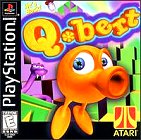
 The Game: Q*World is attacked by the evil purple snake Coily, and the apple of Q*Bert’s eye, Q*Dina, is abducted by Coily, along with several others. Q*Bert pursues Coily through several dimensions to rescue his friends. (Hasbro Interactive/Atari, 1999)
The Game: Q*World is attacked by the evil purple snake Coily, and the apple of Q*Bert’s eye, Q*Dina, is abducted by Coily, along with several others. Q*Bert pursues Coily through several dimensions to rescue his friends. (Hasbro Interactive/Atari, 1999)
Memories: Another quest-style revival of an arcade classic, this new version of Q*Bert still manages to stay faithful to the original, perhaps even moreso than Pac-Man World. While one never had to deal with the yellow fellow jumping, butt-bouncing, or rev-rolling, Q*Bert sticks to the mode of movement from the original game – hopping around diagonally. In short, if you could play the original, you can play this.
Monopoly
 The Game: Does anyone not know this game? You and quite a few other players make a mad dash around the Monopoly board, snatching up properties, railroads, and utilities, hazarding the fickle fortunes of the Chance and Community Chest spaces, and trying to avoid taxes and jail – not to mention bankruptcy – while building an empire that will make you rich. (Majesco Sales, 1999)
The Game: Does anyone not know this game? You and quite a few other players make a mad dash around the Monopoly board, snatching up properties, railroads, and utilities, hazarding the fickle fortunes of the Chance and Community Chest spaces, and trying to avoid taxes and jail – not to mention bankruptcy – while building an empire that will make you rich. (Majesco Sales, 1999)
Memories: This is sort of like the Game Boy editions of Pac-Man and Space Invaders – it’s an excellent reason to own one of Nintendo‘s portable powerhouses o’ fun. The Parker Brothers board game classic is faithfully reproduced despite the small screen, and the game play is engaging. In many ways, I prefer the Game Boy version of Monopoly to the PC or Playstation versions for the same reason I’d take the Game Boy version of Who Wants To Be A Millionaire? over the Playstation version of that game: no cutscenes, no animations you can’t bail out of (or shut down from the options menu), no bull – the Game Boy has just enough room for the game. And I like it that way.
Godzilla Generations
![]() The Game: Smash your way though half a dozen cities as one of several incarnations of Godzilla. (Sega, 1999)
The Game: Smash your way though half a dozen cities as one of several incarnations of Godzilla. (Sega, 1999)
Memories: Some people claim the Dreamcast tanked due to the release of Sony’s Playstation 2. Others say the Dreamcast failed because of widespread piracy of the system’s games. My own personal theory is that the Dreamcast failed because Godzilla Generations sucked so badly.
Frogger
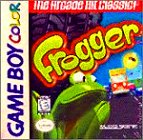
 The Game: You are a frog. Your task is simple: hop across a busy highway, dodging cars and trucks, until you get the to the edge of a river, where you must keep yourself from drowning by crossing safely to your grotto at the top of the screen by leaping across the backs of turtles and logs. But watch out for snakes and alligators! (Majesco, 1999)
The Game: You are a frog. Your task is simple: hop across a busy highway, dodging cars and trucks, until you get the to the edge of a river, where you must keep yourself from drowning by crossing safely to your grotto at the top of the screen by leaping across the backs of turtles and logs. But watch out for snakes and alligators! (Majesco, 1999)
Memories: Ah, the joys of Frogger. It’s still one of the simplest and most deceptively difficult arcade games  ever to come down the pike, and yet finding a decent port of it over the years has proven to be almost as difficult as getting the amphibious one across the road in the game’s sixth level. But ask anyone about favorite video games from the early 80s, and you’re almost certain to hear Frogger in that list. The popularity of the original Frogger is borne out by the fact that a series of licensees has attempted to turn out a modern-day descendant of Frogger, and while some of those have been fun in their own right, they’ve also barely lived up to the simple joy of the original.
ever to come down the pike, and yet finding a decent port of it over the years has proven to be almost as difficult as getting the amphibious one across the road in the game’s sixth level. But ask anyone about favorite video games from the early 80s, and you’re almost certain to hear Frogger in that list. The popularity of the original Frogger is borne out by the fact that a series of licensees has attempted to turn out a modern-day descendant of Frogger, and while some of those have been fun in their own right, they’ve also barely lived up to the simple joy of the original.
Centipede

 The Game: You are the chosen one! Cool, huh? Oh, wait…chosen for what? You are Wally, a bumbling elf who is apparently destined to rid the elven world of a vicious army of centipedes and other bugs. You travel from village to village in different locales to undertake your divine exterminating duties, armed with a hovering weapons platform/vehicle simply called the Shooter. (Hasbro Interactive, 1999)
The Game: You are the chosen one! Cool, huh? Oh, wait…chosen for what? You are Wally, a bumbling elf who is apparently destined to rid the elven world of a vicious army of centipedes and other bugs. You travel from village to village in different locales to undertake your divine exterminating duties, armed with a hovering weapons platform/vehicle simply called the Shooter. (Hasbro Interactive, 1999)
Memories: Sometimes it seems as though the modern video game manufacturers are overdoing their attempts to bestow a Hollywood plot upon the simpler games of the past. Exhibit A: Centipede, based on the mega-hit Atari coin-op of the same name – a game which, to my knowledge, never really needed a plot because most people don’t look kindly upon wormlike creatures with a hundred legs anyway.
Battleship
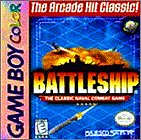 The Game: Two fleets of four warships conduct long-distance naval warfare, randomly firing torpedoes (and occasionally some higher-powered ordnance) at each other, guessing at the positions of their targets. Whoever sinks the entire opposing fleet first is the victor. (Hasbro Interactive, 1999)
The Game: Two fleets of four warships conduct long-distance naval warfare, randomly firing torpedoes (and occasionally some higher-powered ordnance) at each other, guessing at the positions of their targets. Whoever sinks the entire opposing fleet first is the victor. (Hasbro Interactive, 1999)
Memories: This game will always have a special place in my heart. Imagine, if you will, my new bride and I, laying in bed on our honeymoon, glistening candlelight reflected in our link cable, trying to blow up each other’s fleets in a two-player death match. Most couples wait a while before they try to shred each other viciously. But this is one of those advances they talk about with modern technology.
Asteroids

 The Game: As the pilot of a lone space cruiser, you must try to clear the spaceways of a swarm of free-floating asteroids, but the job isn’t easy – Newton’s laws of motion must be obeyed, even by asteroids. When you blow a big rock into little chunks, those chunks go zipping off in opposite directions with the speed and force imparted by the amount of energy you used to dispel them. To that screenful of bite-sized chunks o’ death, add an unpredictable hyperspace escape mechanism and a pesky UFO that likes to pop in and shoot at you, and you’re between several large rocks and a hard place. (Activision, 1999)
The Game: As the pilot of a lone space cruiser, you must try to clear the spaceways of a swarm of free-floating asteroids, but the job isn’t easy – Newton’s laws of motion must be obeyed, even by asteroids. When you blow a big rock into little chunks, those chunks go zipping off in opposite directions with the speed and force imparted by the amount of energy you used to dispel them. To that screenful of bite-sized chunks o’ death, add an unpredictable hyperspace escape mechanism and a pesky UFO that likes to pop in and shoot at you, and you’re between several large rocks and a hard place. (Activision, 1999)
Memories: Another entry in the race to revive as many video game classics as possible (at least the popular ones – I don’t see anyone reviving Bagman…), Activision’s update of Asteroids is fairly straightforward. This is the same company which produced such a winning resurrection of Space Invaders, so we can trust that these people know what makes for a good Retro Revival.
Activision Classic Games
 The Game: Old Atari cartridges taking up too much space in your apartment? Have no fear – a huge portion of Activision’s catalog of titles for the 2600 have been squeezed onto a single CD. (Activision, 1999)
The Game: Old Atari cartridges taking up too much space in your apartment? Have no fear – a huge portion of Activision’s catalog of titles for the 2600 have been squeezed onto a single CD. (Activision, 1999)
Memories: Now, this is a trip back in time! Activision has recycled many of its early Atari 2600 games for this release, perfectly translated for the Playstation and looking just like they did nearly 20 years ago.
Starcon
![]() The Game: In a first-person space shooter set in the Star Control universe, the player is charged with maintaining order in the spaceways, a job made a little more difficult by rival warlords trying to stake their claims on the interstellar shipping lanes. Your patrol ship is armed to the teeth, which is good – because so are their ships. (Accolade, 1998 – never released)
The Game: In a first-person space shooter set in the Star Control universe, the player is charged with maintaining order in the spaceways, a job made a little more difficult by rival warlords trying to stake their claims on the interstellar shipping lanes. Your patrol ship is armed to the teeth, which is good – because so are their ships. (Accolade, 1998 – never released)
Memories: Left in an unfinished state and never officially released, Starcon represents the most recent, and most baffling, attempt to drag the Star Control universe into the console realm. It’d already been done spectacularly well on the 3DO with Star Control II, which actually managed to trump the original PC version in some respects. But while the Playstation should’ve been capable of an equally spectacular port of Starcon II, Accolade instead licensed the name, and some placenames and species, for a game that has almost nothing to do with the rest of the series.
Star Trek: Starship Creator
![]() The Game: Starfleet is looking for a few good Admirals. Despite the fact that these ubiquitous high-ranking officers are peppered liberally throughout the various Trek series, you’ve been recruited as one too – and your job is to be less
The Game: Starfleet is looking for a few good Admirals. Despite the fact that these ubiquitous high-ranking officers are peppered liberally throughout the various Trek series, you’ve been recruited as one too – and your job is to be less  ineffectual than most of the TV Admirals! You get to design, outfit and crew Federation starships to your specifications – within, of course, reasonable budgetary limits. Then dispatch your ships – one at a time, or an entire fleet – to do everything from study stellar anomalies to hold the line at the Cardassian border. The equipment you choose, as well as the interactions of the various crew members’ personalities, will play a part in the outcome of your fleet’s assignments. (Simon & Schuster Interactive, 1998)
ineffectual than most of the TV Admirals! You get to design, outfit and crew Federation starships to your specifications – within, of course, reasonable budgetary limits. Then dispatch your ships – one at a time, or an entire fleet – to do everything from study stellar anomalies to hold the line at the Cardassian border. The equipment you choose, as well as the interactions of the various crew members’ personalities, will play a part in the outcome of your fleet’s assignments. (Simon & Schuster Interactive, 1998)
 Memories: This sim-style game is almost exactly the same basic concept as the classic Apple II game Project Space Station, but in a science fiction setting. That game, too, put you in charge of designing, budgeting, populating and constructing a spacecraft. The only difference is that Starship Creator only allows you to monitor your ship’s activities from afar, not even able to advise. Project Space Station at least featured arcade-style segments in which you pilot space shuttles and construction pods. But if you give it any thought, Starship Creator is true to the Star Trek universe – you, the Admiral, are helpless to do anything but shake your head as those pesky, willful Captains in your fleet do their own creative rewriting of Starfleet regulations.
Memories: This sim-style game is almost exactly the same basic concept as the classic Apple II game Project Space Station, but in a science fiction setting. That game, too, put you in charge of designing, budgeting, populating and constructing a spacecraft. The only difference is that Starship Creator only allows you to monitor your ship’s activities from afar, not even able to advise. Project Space Station at least featured arcade-style segments in which you pilot space shuttles and construction pods. But if you give it any thought, Starship Creator is true to the Star Trek universe – you, the Admiral, are helpless to do anything but shake your head as those pesky, willful Captains in your fleet do their own creative rewriting of Starfleet regulations.
Star Trek: Starfleet Academy – Strategic Command
![]()
 The Game: You’ve just embarked on the most challenging field of study at Starfleet Academy: Command College. Your instructor, the recently-promoted Captain Sulu (still two years away from his command of the U.S.S. Excelsior), arrives just a little bit late for his first lecture. Your initial missions include such tasks as destroying minefields, but your assignments soon grow in both complexity and risk. Not only must you battle alien threats in Starfleet’s most advanced simulator, but you must also get your crew to cooperate and learn how to lead them. (Interplay, 1998)
The Game: You’ve just embarked on the most challenging field of study at Starfleet Academy: Command College. Your instructor, the recently-promoted Captain Sulu (still two years away from his command of the U.S.S. Excelsior), arrives just a little bit late for his first lecture. Your initial missions include such tasks as destroying minefields, but your assignments soon grow in both complexity and risk. Not only must you battle alien threats in Starfleet’s most advanced simulator, but you must also get your crew to cooperate and learn how to lead them. (Interplay, 1998)
Memories: Though it’s mired in the mid-1990s trend of endless cutscenes and movies, inside Starfleet Academy is actually a fun little game, really more or less a 90s update of the old Star Trek arcade game with much flashier graphics (not the least of which is the full-motion video foreground of your crewmembers at the helm and at other stations) and a slightly different storyline.
Dune 2000
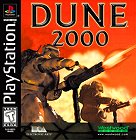
![]()
 The Game: The Padishah Emperor has declared open season on the planet Arrakis – better known as Dune. With no rules and no limits, the Houses of Atreides, Harkonnen and Ordos are cordially invited to mine the precious Spice from Dune’s subsurface strata – and smash each other into smithereens with any and all weapons and technologies available. (Electronic Arts [developed by Westwood Studios], 1998)
The Game: The Padishah Emperor has declared open season on the planet Arrakis – better known as Dune. With no rules and no limits, the Houses of Atreides, Harkonnen and Ordos are cordially invited to mine the precious Spice from Dune’s subsurface strata – and smash each other into smithereens with any and all weapons and technologies available. (Electronic Arts [developed by Westwood Studios], 1998)
Memories: Dune 2000 is an updated version of the Dune 2 computer game that has been around for a few years. I’ll warn you right now, and I’m only doing this because I feel it’s a valid warning…Dune 2000 is extremely addictive. It’s right up there with SimCity and the Ultima games – proving that complex computer games can eat up just as much time as any ultra-simple arcade-style action game.
Amok!
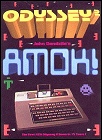 The Game: You’re alone in a maze filled with armed, hostile robots who only have one mission – to kill you. If you even so much as touch the walls, you’ll wind up dead. You’re a little bit faster than the robots, and you have human instinct on your side…but even that won’t help you when SmileyBot, a deceptively friendly and completely indestructible smiley face, appears to destroy you if you linger too long in any one part of the maze. The object of the game? Try to stay alive however long you can. (John Dondzila Classic Gaming Creations, 1998)
The Game: You’re alone in a maze filled with armed, hostile robots who only have one mission – to kill you. If you even so much as touch the walls, you’ll wind up dead. You’re a little bit faster than the robots, and you have human instinct on your side…but even that won’t help you when SmileyBot, a deceptively friendly and completely indestructible smiley face, appears to destroy you if you linger too long in any one part of the maze. The object of the game? Try to stay alive however long you can. (John Dondzila Classic Gaming Creations, 1998)
Memories: One day, an avid programmer named John Dondzila decided to program a new game for the Odyssey – or, more precisely, for the Odyssey2 Emulator created by Dan Boris. The game turned out well, and Dondzila offered the game for sale in cartridge form through his web site. The result was the first new game cartridge for the Odyssey 2 since the mid 1980s.
Doctor Who: Destiny of the Doctors
![]()
 The Game: The Master strikes again! The evil Time Lord has trapped the Doctor’s first seven incarnations. You assume the role of the Graak, a telepathic entity created by the Doctor in the event of just such an emergency. You must travel to different time zones to rescue the Doctor’s various incarnations, battling Daleks, Cybermen, Silurians, Sontarans, Yeti, Ice Warriors, Autons, Zygons and more along the way. You may be able to make telepathic contact with the Doctor periodically, or use the time-space telegraph to consult with the Brigadier. In the meantime, the Master challenges you to accomplish various hazardous tasks… (BBC Multimedia, 1997)
The Game: The Master strikes again! The evil Time Lord has trapped the Doctor’s first seven incarnations. You assume the role of the Graak, a telepathic entity created by the Doctor in the event of just such an emergency. You must travel to different time zones to rescue the Doctor’s various incarnations, battling Daleks, Cybermen, Silurians, Sontarans, Yeti, Ice Warriors, Autons, Zygons and more along the way. You may be able to make telepathic contact with the Doctor periodically, or use the time-space telegraph to consult with the Brigadier. In the meantime, the Master challenges you to accomplish various hazardous tasks… (BBC Multimedia, 1997)
Memories: Despite the fact that Destiny of the Doctors is essentially a Doom/Duke Nukem engine with Doctor Who settings, villains and soundbytes, I find this game strangely addictive. Even more than Star Trek, Doctor Who has been a part of my pop culture/sci-fi consciousness since childhood, and there’s something appealing about finally getting to plaster some Daleks for myself rather than watching someone else do it on TV.
Xevious 3D/G+

 The Game: Evil aliens are taking over the world and building heavily-fortified installations on land and undersea! Our last defense against them? You – and your well-armed Solvalou Fighter. You can repel air attacks with your lasers, and take out ground bases, missile launchers and tanks with your bombs. (Fortunately, you never run out of either of these!) Every so often, you’ll have to fight the odds to take out one of the aliens’ primary bases – and then you’ll have to deal with the huge “Bosses.” (Namco, 1997)
The Game: Evil aliens are taking over the world and building heavily-fortified installations on land and undersea! Our last defense against them? You – and your well-armed Solvalou Fighter. You can repel air attacks with your lasers, and take out ground bases, missile launchers and tanks with your bombs. (Fortunately, you never run out of either of these!) Every so often, you’ll have to fight the odds to take out one of the aliens’ primary bases – and then you’ll have to deal with the huge “Bosses.” (Namco, 1997)
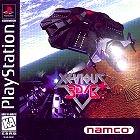 Memories: This somewhat obscure Namco title updates and revives their classic arcade title Xevious, which accumulated a cult following in 1983 when the game was released Stateside by Atari. Truth be told, Xevious 3D/G+ doesn’t rewrite the book or reinvent the wheel. For the most part, the game simply puts the original Xevious in a vaguely third-person 3-D perspective, adds some weapons and enemies (most notably the enormous and hard-to-kill Bosses), and kicks ass graphically. I liked this a lot. It has a great deal of respect and reverence for its source material.
Memories: This somewhat obscure Namco title updates and revives their classic arcade title Xevious, which accumulated a cult following in 1983 when the game was released Stateside by Atari. Truth be told, Xevious 3D/G+ doesn’t rewrite the book or reinvent the wheel. For the most part, the game simply puts the original Xevious in a vaguely third-person 3-D perspective, adds some weapons and enemies (most notably the enormous and hard-to-kill Bosses), and kicks ass graphically. I liked this a lot. It has a great deal of respect and reverence for its source material.
Star Wars: Masters of Teras Kasi
![]()
 The Game: The Emperor, tiring of the constant Rebel threat to his plans for conquest, plays his hidden ace – Arden Lyn, a deceptively young-looking woman who is the last known master of the ancient martial art of teras kasi. Her mission is to hunt down Luke, Han, Leia and the other Rebels…and eliminate them. Little does she know that the Rebels are aware of the new threat to their cause, and are preparing for her arrival as well. (LucasArts, 1997)
The Game: The Emperor, tiring of the constant Rebel threat to his plans for conquest, plays his hidden ace – Arden Lyn, a deceptively young-looking woman who is the last known master of the ancient martial art of teras kasi. Her mission is to hunt down Luke, Han, Leia and the other Rebels…and eliminate them. Little does she know that the Rebels are aware of the new threat to their cause, and are preparing for her arrival as well. (LucasArts, 1997)
Memories: How best to describe Teras Kasi? Think of MTV’s Celebrity Death Match set in the Star Wars universe, and you’ll have a pretty good idea, sans claymation. Teras Kasi could have been more easily titled Star Wars Ultimate Fighting and gotten the point across more succinctly (and probably would’ve sold better as well).
Space Invaders Collection
 The Game: You’re the pilot of a ground-based mobile weapons platform, and there are buttloads of alien meanies headed right for you. Your only defense is a trio of shields which are degraded by any weapons fire – yours or theirs – and a quick trigger finger. Occasionally a mothership zips across the top of the screen. When the screen is cleared of invaders, another wave – faster and more aggressive – appears. When you’re out of “lives,” or when the aliens manage to land on Earth… it’s all over. (Taito, 1997, for Playstation)
The Game: You’re the pilot of a ground-based mobile weapons platform, and there are buttloads of alien meanies headed right for you. Your only defense is a trio of shields which are degraded by any weapons fire – yours or theirs – and a quick trigger finger. Occasionally a mothership zips across the top of the screen. When the screen is cleared of invaders, another wave – faster and more aggressive – appears. When you’re out of “lives,” or when the aliens manage to land on Earth… it’s all over. (Taito, 1997, for Playstation)
Memories: I can hear ’em already. “Okay, you’ve flipped your lid. There’s already a modern-day Space Invaders remake out there, there’s emulation, and then there’s the fact that Space Invaders has been emulated pretty faithfully all the way back to the Atari 2600 version. Why the heck do you need this version for the Playstation?”
ReBoot
![]() The Game: No one said it was easy being Mainframe’s Guardian, and this game is proof. You’re Bob the Guardian, trying to protect the citizens of Mainframe from a series of deadly tears unleashed upon the unsuspecting populace by an unholy alliance between Megabyte and Hexidecimal. Various characters show up along the way, like Mike TV, to offer advice, but aside from some vital health power-ups, you’re on your own. As you advance from level to level, a new ReBoot adventure is gradually revealed until you reach the end of the story – but if you fail in your mission to protect Mainframe, that episode’s going to come up short. (Electronic Arts, 1997)
The Game: No one said it was easy being Mainframe’s Guardian, and this game is proof. You’re Bob the Guardian, trying to protect the citizens of Mainframe from a series of deadly tears unleashed upon the unsuspecting populace by an unholy alliance between Megabyte and Hexidecimal. Various characters show up along the way, like Mike TV, to offer advice, but aside from some vital health power-ups, you’re on your own. As you advance from level to level, a new ReBoot adventure is gradually revealed until you reach the end of the story – but if you fail in your mission to protect Mainframe, that episode’s going to come up short. (Electronic Arts, 1997)
Memories: What better property to base a game on than ReBoot, the all-CGI animated show from Canada which has never gotten a decent time slot in the U.S.? Originally shown on ABC in the early 1990s, ReBoot started out as standard kid-friendly fare. Its second season introduced some more violent elements, after which ABC dropped the show and its third season – complete with battles, psychological drama and character development aplenty – wound up in a dead-of-night slot on the Cartoon Network. (And this treatment of the show hasn’t changed – the fourth season was aired on the Cartoon Network, and went almost completely unpromoted.)
Namco Museum Encore
 The Game: All aboard! Now departing the Namco Museum aboard the spaceship Game Space Milaiya. Namco’s retrospective series literally takes off for its final ride on the Playstation with a collection of seven games, from the earliest days of Namco’s video game empire to more recent arcade titles. (Namco, 1997 – for Playstation)
The Game: All aboard! Now departing the Namco Museum aboard the spaceship Game Space Milaiya. Namco’s retrospective series literally takes off for its final ride on the Playstation with a collection of seven games, from the earliest days of Namco’s video game empire to more recent arcade titles. (Namco, 1997 – for Playstation)
Memories: For the final PS1 outing of the Namco Museum series, Namco turned out what easily could have been the user-friendliest volume yet, dispensing with the tedious “Doom minus the action” museum settings and otherwise simplifying things dramatically. In short: doing away with the extraneous trappings to make way for more games.
Frogger

 The Game: Frogger is back for another ribbeting chase through the traffic, and countless other locales as well. The object of the game is to rescue as many baby frogs as possible without croaking. Jump on anything that moves – provided it doesn’t eat you – to reach your goal. (Hasbro Interactive, 1997)
The Game: Frogger is back for another ribbeting chase through the traffic, and countless other locales as well. The object of the game is to rescue as many baby frogs as possible without croaking. Jump on anything that moves – provided it doesn’t eat you – to reach your goal. (Hasbro Interactive, 1997)
Memories: One of the earlier Retro Revivals to appear in the past couple of years, Frogger doesn’t quite live up to its arcade ancestry as an addictive, play-and-play-again game. My favorite screen is still the “retro level,” which is basically the arcade screen – a busy street followed by a hazardous river – given a 3-D makeover. Once you get past that screen, you might as well be playing a different game.
Command & Conquer: Red Alert
![]()
 The Game: It’s the Cold War all over again – but worse. Tampering with the timeline has wreaked immeasurable damage with the development of technology, and the result is a new wave of deadly weapons, including Tesla tanks and turrets (which discharge immense electrical energy at their opponents) and Chrono-tanks (which can shift their position on the map instantly for a brief time). You must build and protect your base, produce units necessary to defend and attack, and orchestrate an invasion of enemy territory – all while accumulating as few casualties as possible. (Electronic Arts [developed by Westwood Studios], 1996)
The Game: It’s the Cold War all over again – but worse. Tampering with the timeline has wreaked immeasurable damage with the development of technology, and the result is a new wave of deadly weapons, including Tesla tanks and turrets (which discharge immense electrical energy at their opponents) and Chrono-tanks (which can shift their position on the map instantly for a brief time). You must build and protect your base, produce units necessary to defend and attack, and orchestrate an invasion of enemy territory – all while accumulating as few casualties as possible. (Electronic Arts [developed by Westwood Studios], 1996)
Memories: Westwood’s real-time strategy classic is a major evolutionary leap from the original Command & Conquer, with vast improvements in the artificial intelligence used by both your soldiers and by computer controlled enemies. And it’s a tough game! It’s pretty common practice for me, despite a couple of years of playing Dune 2000 (a later Westwood game which is built on the same engine as Red Alert), to build up quite a nice base and then get my ass kicked big time.
Tempest X3

 The Game: As in the original Tempest, you scuttle along the rim of an abstract, hollow geometric tube as a strangely crablike creature, zapping red bow-tie-ish critters and purple diamond-shaped things which carry them. There are also swirly green things (swirly thing alert!!) which spin “spikes” like webs, and by the way, you should still avoid spikes. (Interplay, 1996)
The Game: As in the original Tempest, you scuttle along the rim of an abstract, hollow geometric tube as a strangely crablike creature, zapping red bow-tie-ish critters and purple diamond-shaped things which carry them. There are also swirly green things (swirly thing alert!!) which spin “spikes” like webs, and by the way, you should still avoid spikes. (Interplay, 1996)
Memories: My first reaction to Tempest X3 was “DUDE!” And that’s not even a “Dude! It sucks!” or “Dude! It rules!” Nope, it’s just a “Dude! What gnarly graphics!” This is kind of like the original Tempest, except psychedelically tie-dyed. To put it mildly, it’s a very…colorful updating of the game. The tube walls now have colorful (if subtle) patterns, and power-ups are hailed by more lens flares than an early episode of Babylon 5.